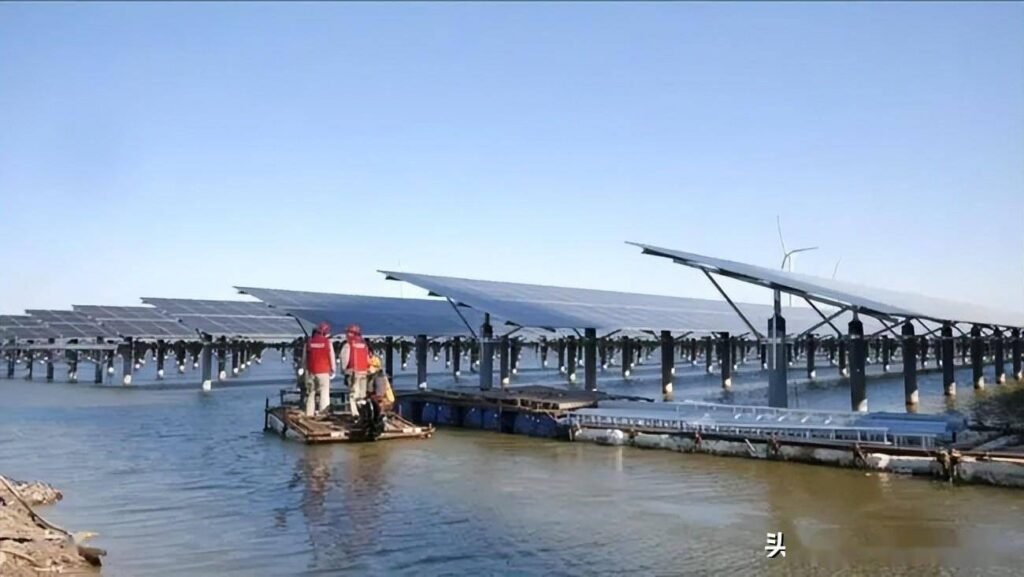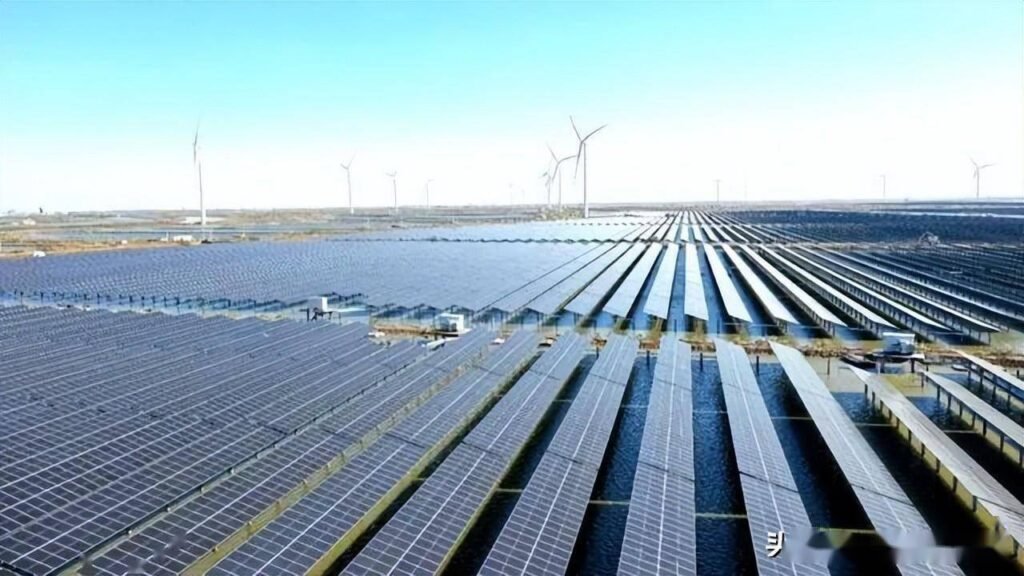
Fishing and light complementarity is a clean and efficient production method that has developed rapidly in recent years, providing a huge opportunity for aquaculture. It has the characteristics of clean, low-carbon, and high-efficiency, but there are gaps in basic research, non-standard facilities and systems, and breeding techniques. Insufficient skills and so on. This paper introduces the concept and characteristics of fishery and photovoltaic complementarity in detail, and analyzes the economic, ecological, and ecological aspects of fishery and photovoltaic complementarity. social value, and put forward development suggestions based on the problems existing in the development process, in order to promote the health of my country’s fishery and photovoltaic complementary industry. Sustainable development provides a reference. In the fishing-light complementary mode, the power of the solar module is transferred due to the low temperature near the water surface.High conversion efficiency; the evaporation rate of the water surface is reduced by more than 70% due to the shading of solar panels, saving a lot of aquaculture water; environment-friendly The farming and power generation model promotes the redevelopment of the ecosystem; the use of intelligent fishery systems to control the farming environment, thereby improving High fish growth rate, improve the economic benefits of farming. In addition, from the perspective of energy saving and emission reduction, if the national light intensity.Average value combined with fish-light complementary technology, based on the aquaculture area currently in use, will generate more than 50 MWh per year,electricity, save about 18 billion tons of standard coal, and reduce 49.85 Mt of carbon dioxide emissions. Complementary fishery and light is to achieve the “two carbon goals”With the continuous deepening of research, the ecological and economic value of fishery-optical collaboration will continue to emerge, further promoting the clear,Clean energy production and green development of aquaculture.
China is the largest aquaculture country in the world, with aquaculture output of 52.242 million tons, accounting for 79.8% of the country’s total fishery output, and providing about 1/3 of high-quality animal protein for urban and rural residents.

China’s aquaculture mainly adopts ponds, large water surfaces, tidal flats, rice fields and other farming methods, and the aquaculture area exceeds 7.036 million hm2. Since aquaculture is still mainly based on resource consumption growth, traditional aquaculture has a large environmental impact and high energy consumption. Problems such as low production efficiency and low production efficiency have gradually emerged and become the main bottleneck restricting the healthy development of aquaculture . Since the “Twelfth Five-Year Plan”, the state has put forward the fishery development goal of “improving quality and efficiency, reducing production and increasing income, green development, and enriching fishermen”, emphasizing the continued deepening of fishery supply-side structural reforms, high-quality development and steady promotion of fishery development. “Fishing and light complementarity” is a new fishery method that originated in China since the 21st century, and it is a new technology for water power generation and underwater aquaculture . Fishing and solar complementarity combines solar power generation with aquaculture, does not occupy additional land resources, has low management costs, low breeding costs, energy saving and
Advantages of travel and leisure tourism potential . my country has a huge demand for energy and mainly relies on fossil fuels. The burning of a large amount of fossil fuels leads to an increase in greenhouse gases and global warming . If fossil fuels continue to be used, the pH of global water bodies will drop by 0.5 units by 2100 , lead to catastrophic ecological events such as ocean acidification and aquatic species extinction, which will have a profound impact on the earth environment on which we live, requiring us to turn to clean and sustainable.
Renewable energy . Reducing carbon emissions and improving carbon removal are the main ways for the aquaculture industry to implement the “two carbon targets”. Fishing and solar complementarity is a clean and low-carbon fishery production method. Carrying out research on fishery and solar complementarity is crucial to promoting my country’s aquaculture industry. Quality development is of great significance to increase fishermen’s income.
“Fishing and solar complementarity” refers to the combination of aquaculture and photovoltaic power generation. The fishery model in which photovoltaic panels are installed above the aquaculture facilities to generate electricity and aquaculture activities are carried out in the waters below the photovoltaic panels has the characteristics of sustainable development on the water.

Continue to produce clean energy, produce high-quality aquatic products underwater, and “fishery, electricity, and environmental protection” are the characteristics of Sanfengshou. Complementary fishing and photovoltaics are generally built on ponds, lakes, reservoirs and other aquaculture waters in areas with rich light intensity. While building photovoltaics, new or rebuilt or expanded aquaculture facilities are constructed to prevent non-point source pollution and internal and external source pollution. Ecologically healthy breeding areas, as well as supporting modern fishery facilities, equipment and intelligent management systems. Fishing and solar complementarity overcomes the problem of land occupation for photovoltaic power generation on land and improves land output. In addition, fish-light complementarity has changed the structure of traditional breeding facilities, changed the environmental conditions of breeding, extended the breeding cycle, and increased the breeding output. Compared with traditional aquaculture, fishery-light complementarity has changed the problem of single income and being easily affected by the market. In addition to satisfying the electricity consumption of aquaculture, it can also be connected to the grid to obtain electricity income, which is conducive to large-scale promotion. Generally speaking, “fishing and light complementarity” is a new agricultural model that integrates various advantages such as breeding, power generation, environmental protection, and tourism. As of the end of 2020, my country’s cumulative installed capacity of renewable energy has reached 934 million kW, accounting for one-third of the world’s total installed capacity of renewable energy, especially wind power and photovoltaics. , More than half of the new installed capacity of photovoltaics. Large-scale development of renewable energy in my country

The exhibition has also effectively promoted the progress of new energy technologies represented by wind power and photovoltaics, making global renewable energy, especially wind power and photovoltaics, the new main energy source. For the global energy transition, to deal with climate change climate change has made China’s contribution.
My country’s fishery-photovoltaic complementary industry has developed rapidly. Due to the lack of related research on breeding species and breeding facility construction technology, the overall technical level of fishery-photoelectric complementary is low, and the breeding benefits are not high. Photovoltaic areas.
The pollution of aquaculture waters is still serious [69], which does not meet the requirements of the green development of aquaculture. It is necessary to carry out systematic research from the perspective of industrial ecology, and fully consider the synergy, matching and complementarity between fishery production and photovoltaic power generation. According to the green aquaculture It is required to establish a breeding technology system. Fishing and solar complementarity in tidal flats should be based on the reliable power provided by offshore platforms, and a series of ecological fish farming models for recycling marine resources should be established. In the construction of fishery and photovoltaic integration in inland lakes and reservoirs, the comprehensive impact on the large water surface ecosystem should be fully considered, and an evaluation system should be established; in the construction of fishery and photovoltaic complementarity in inland ponds, attention should be paid to the impact of fishery and photovoltaic complementarity on the environment, as well as the impact of breeding facilities. The structural form and breeding management, etc. In addition, the development of “complementary fishing and photovoltaic” can focus on the science education of the photovoltaic industry, increase the popularization of photovoltaic power generation knowledge, advocate low-carbon life, promote the sharing of scientific and technological resources and the socialization of science popularization work. Reasonably plan and build science and education bases based on geographical advantages, carry out science popularization activities, improve the scientific and technological quality of the whole people, give full play to the role of technological innovation, and lead the green development of “complementary fishing and light”.

